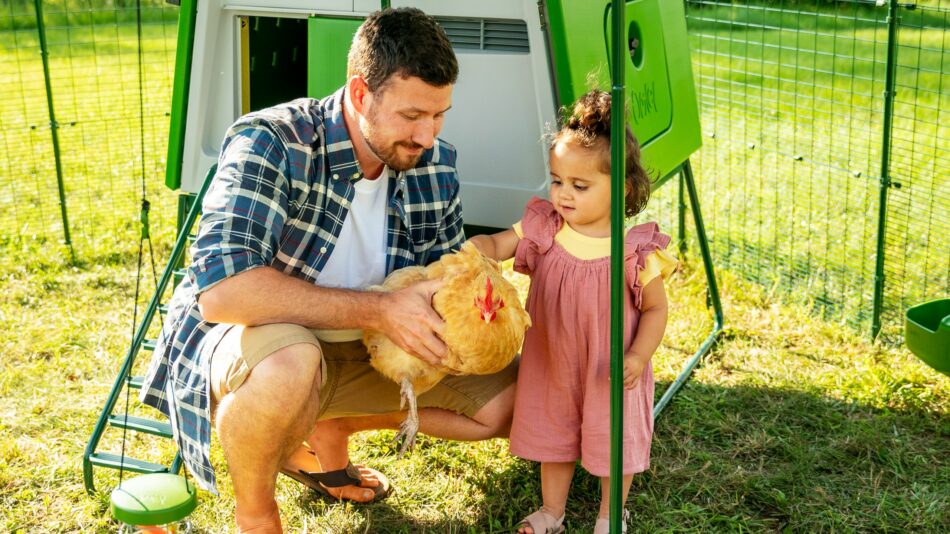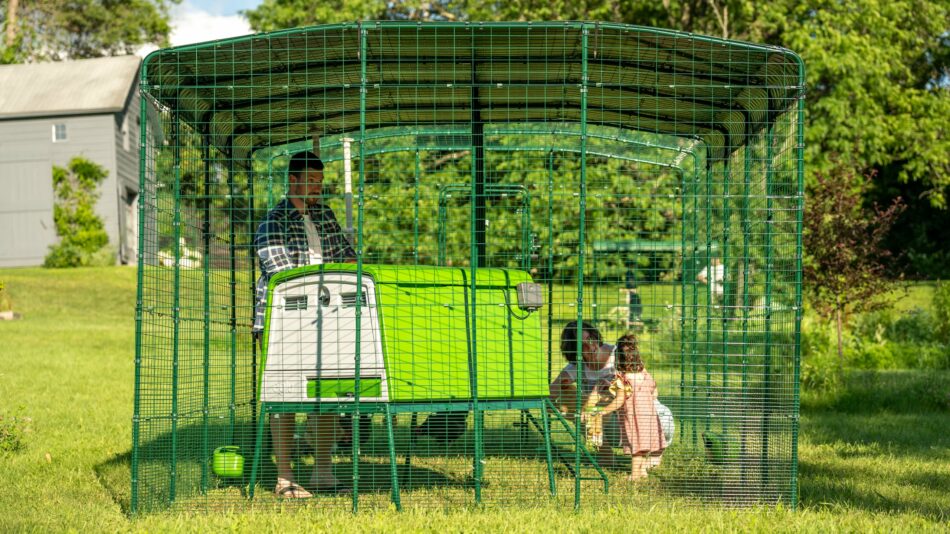Steps to familiarize chickens with the human touch
Chickens can bond with their owners, much like other domesticated pets. While holding hens may not be what immediately comes to mind when people envision owning chickens, there are breeds that will tolerate or even enjoy being held by their owners. Chickens aren’t hatched with an innate desire to be handled, but you can take steps to familiarize chickens with the human touch – no matter how old they are. Find out how time, patience, and your setup can help build a deeper bond between you and your flock.
Are chickens affectionate?
As prey animals, chickens aren’t naturally trusting of humans – but that doesn’t mean they can’t be persuaded by your efforts. While some individual chickens may be more outgoing and comfortable around their owners, it’s possible to earn the trust of your other flock members. Patience and consistency are key when gaining the trust of your flock.
The easiest chickens to tame are those that have been handled since they were hatched. Talking to, petting, and handling chicks from a young age will help them understand that you are a friend and not a foe. Physical contact should remain consistent throughout their development to make them as tame as possible as adults.
Chickens that have been rescued can become comfortable with being handled, but you’ll need an abundance of patience. While trust is hard-won, it’s easily lost through mistreatment or neglect. Or, it may be that rescued hens have simply never had any human contact. Whatever the case may be, the steps to familiarize chickens with the human touch are the same for rescued hens as it is for chicks or mature hens.
What about roosters?
Roosters are a bit of a wild card when it comes to being handled. Some roosters are extremely affectionate, while others can be stand-offish or even aggressive toward humans. Since they are at the top of the pecking order in a flock, most roosters have big personalities one way or the other. Keeping roosters is a matter of personal preference, but the same methods used for taming hens can be applied to roosters.
Most affectionate chicken breeds
Just like other pets, each chicken will have their own personality. Some breeds and individual chickens will be more receptive to being petted, held, and handled. Here are the breeds of chickens best known for being the most affectionate toward humans:
Silkies are known as the “lap dogs”, and Orpingtons are known as the “golden retrievers” of chickens. These comparisons to man’s best friends pay homage to the personalities of their breed, but unlike dogs, they still aren’t hardwired to accept human touch. All of these breeds that make the list for being the most affectionate toward humans still need to be won over by their owners – but they’re the most likely to be easily swayed, making them a standout choice for those wanting a flock that can be handled.
3 steps to familiarize chickens with the human touch
Familiarizing your chickens with human touch can be accomplished through time and patience. Depending on your hens’ personalities, age, and background, you can expect being able to handle them effortlessly to come only after a period of training and consistency.
Handle early
If possible, handle your hens from an early age. Newly hatched chicks can be handled with care from the time they’re 2 or 3 days old. If you have older pullets or mature hens, let them settle into their new home over the course of a week or two before introducing the concept of human touch. Establish a routine from the start that your flock can expect. When they’re let out, when they’re fed, and when treats are brought should be highly anticipated events for your hens.
Having a Walk In Chicken Run for your flock makes this process even easier. Stepping into their habitat regularly with positive experiences reinforces trust and affection between you and your chickens. By walking with your flock daily, they’ll start to see you as a normal and enjoyable aspect of their everyday routine and environment.
Beyond the Walk In Chicken Run, you can use Chicken fencing to create a safe perimeter for your flock to enjoy. Our chicken fencing has convenient gates for you to easily enter into your hens’ area to enjoy time with them.
Handle often
Once your hens have accepted you as the giver of food and a regular run visitor, it’s time to incorporate human touch. Start with a chair or stool inside of the run and simply sit with your flock while they go about their business. This new sight might inspire more curious hens to approach you. You can reach out slowly to pet these bolder hens, or sit quietly and let them set the pace.
Keep scratch grains, dried insects or leafy greens with you to reward their curiosity with hand-fed treats. After a few sessions of hand-feeding, move to sit on the ground if possible and encourage your hens to take their treats from your lap. If sitting on the ground isn’t comfortable, move your chair over toward a chicken perch and encourage them to hop onto your lap for their treats.
Repeat this process as often as possible for maximum benefits. Some hens will warm up to you in just a few hours, while others may take several days or weeks. But, once one hen has the courage to make the leap onto your lap, the rest are usually soon to follow.
Handle with care
Once your hens are confidently taking treats from your hand or lap, it’s time to embrace them – literally. Slowly start wrapping an arm around your hens, being sure to encompass both of their wings to prevent them from flapping. Pet them gently and offer more treats by hand. Start out with short holding sessions of no more than a minute or two, working toward longer embraces.
After your hens become used to being held this way, stand up slowly and go for a short walk with them. If your hens object or become nervous, stand still and pet them until they have calmed. Reward their compliance by placing them down near their favorite chicken toys, or another favorite spot in the run.
Your hens are making great strides at this point, but it’s important not to push them too quickly. As the old adage goes: two steps forward, one step back – too much too soon can set your hens back and diminish some of the confidence you’ve helped them build.
What not to do
It may be tempting to rush through the process, or throw in the towel when you don’t think you’re making progress. But, as with many endeavors, success is just around the corner. Be patient with your flock, keeping in mind that as prey animals they can be stressed or startled easily.
When training your chickens to accept human touch, remember:
- Never chase or grab at your hens as they pass you in order to catch them
- Don’t expect too much too soon – every hen progresses at their own pace
- Wait for your hens to complete one milestone before moving on to another
If you let your chickens set the pace, you’ll be delighted to find your bond growing through mutual respect and thoughtful consideration. Remember: your hens are regarding and evaluating you, just as you are them.
Omlet and your flock
Our Walk In Chicken Runs, Chicken Fencing and Chicken Toys and Accessories make building a bond with your flock easy and enjoyable. Foster their natural behaviors and curiosity with our expertly designed products, while making spending time with your chickens effortless. See why chicken keepers who choose Omlet for their flocks’ needs enjoy a more fulfilling experience and deeper relationships with their hens that last a lifetime.
This entry was posted in Chickens



One reply on “Steps to familiarize chickens with the human touch”
I have a white Leghorn that loves to cuddle with me everyday, several times a day. Leghorns are known for being flighty and standoffish, so this is highly unusual for her. If I work alot, like now, and don’t get home until after dark, she gives me the human equivalent of the stink eye and silent treatment.